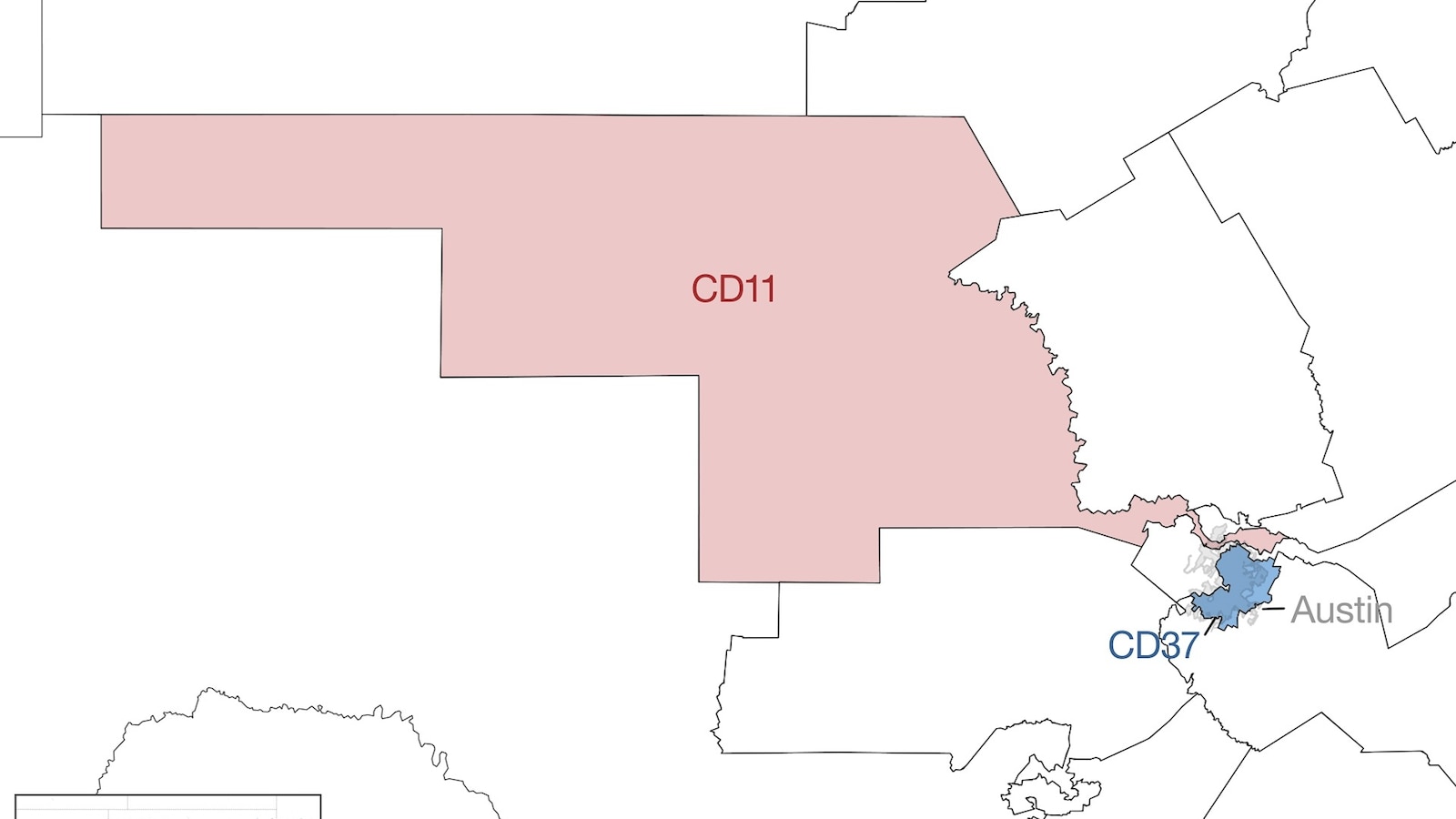As Texas Republicans try to muscle a rare mid-decade redistricting bill through the Legislature to help Republicans gain seats in Congress – at President Donald Trump’s request – residents in Austin, the state capital, could find themselves sharing a district with rural Texans more than 300 miles away.
The proposed map chops up Central Texas’ 37th Congressional District, which is currently represented by Democrat Rep. Lloyd Doggett, will be consumed by four neighboring districts, three of which Republicans now hold.
One of those portions of the Austin-area district was drawn to be part of the 11th District that Republican Rep. August Pfluger represents, which stretches into rural Ector County, about 20 miles away from the New Mexico border.



The worst part is that democrats will fight back by gerrymandering harder, and it just won’t be as effective because gerrymandering always benefits the person behind. If democrats had an ounce of intelligence, they would be fighting for standard algorithms to manage redistricting. If it was federal law to minimize district perimeters, this whole nonsense would end.
The problem with that is they would need to regain power to be able to fix anything. But that would also assume they did, in fact, have the intelligence to fix problems while in power. Unfortunately, the reason the fascists are fighting so hard to dismantle democracy is to ensure that they can never lose power again despite their growing unpopularity.
It’s a bit more complex than that—if you create districts on a purely geographic basis (like minimizing district perimeters), you usually amplify slight majorities into disproportionately large ones (e.g., a 55% demographic majority translating to a 90% legislative majority). An algorithm that tries to create districts that proportionally translate demographics to representation usually ends up with district boundaries that superficially resemble gerrymandered ones.
I think this is an important point that https://bdistricting.com/2020/ glosses over. Some of the representation “guarantees” that were part of the VRA are actually defeated by doing purely geographic districting. Oft-times there’s enough BIPOC population that’s widely distributed, but needs to be “packed” (to use the gerrymandering terminology) in order to given even a chance of proportional representation.
My state of Arkansas is a good example https://bdistricting.com/2020/AR_Congress/ BIPOC is >= 25% of the population, but to get a distract that was 50% BIPOC it would have to snake across the state in a way that would be very visually similar to a gerrymandered district.
Multi-member districts can help, but they cause a loss of representation locality.
It may be that it’s impossible to produce an algorithm that satisfies all our (collective) fairness constraints.
https://www.youtube.com/watch?v=Lq-Y7crQo44
This is a really neat video about algorithmic redistricting. It doesn’t really make any claims about the politics around drawing maps but it does a great job of showing how easily the maps can be manipulated to give set results. It’s really neat to see how the different things we can optimize for may or may not produce “fair” results.
Really worth a watch imo!
Except we’re talking about Texas, where Democrats have never held enough power to do any significant gerrymandering. Assuming you’re acting in good faith and not just a bot, is it possible that you’re failing into the trap of assuming that because one of the most heavily gerrymandered districts (Texas 35th) is blue that Democrats did the gerrymandering?
They didn’t. Republicans did, to pack as many blue votes into a single district as possible so multiple others around it could be red. If the districts were drawn fairly, the thin corridor connecting Austin and San Antonio would be red, and multiple districts above and below that corridor would be blue.
Lol except democrats have been using bipartisan/non-partisan commissions to do it in blue states, so it means the house will forever be favoring republicans, unless democrats actually have the spine to play dirty.
Oh? Then why are repubs gerrymandering so hard? Because they’ll pick up 5 seats in Texas by doing it. And they’re going to do the same in all the red states they can and pick up an extra one here and an extra one there and get a nice, cushy permanent House majority by blatantly violating district-drawing “norms” to a mind-boggling degree like this. Because now they can.
But don’t worry about Dems fighting back by doing a damn thing, let alone gerrymandering harder.
New York and California are already starting the redistricting process. This is a poor move by republicans in the long run since more of their states are already maximally gerrymandered.
Good to hear!
Here in the best country on earth we just count the votes of our people and decide based on that. No district bullshit whatsoever. And that is how we ended with a backwards blackrock cocksucker and a corrupt von der leyen… But seriously just count the votes in general, the us has such a fucked up system…
The USA is a union of 50 semi-independent states, not a single homogenous country, which is where most of the complexity comes from.
But, doesn’t your country (you didn’t say which it is) have any districts (or geographic subdivisions of some kind) where the inhabitants living within it send a representative to the national level to advocate for their interests and vote on national legislation with their local interests considered? That’s what we’re talking about here, except with an extra layer in between, where each State (being a semi-independent entity) gets to decide how it draws the boundaries of the districts within it.
we also have states but when we vote for our national government every vote is counted on it’s own whereas in the us the votes win districts which decide on the election outcome and can be manipulated through gerrymandering
Here, the only office not directly elected by popular vote is the US Presidential/Vice Presidential ticket, where it is determined by the infamous Electoral College, where each state has a different number of votes to cast, one for each senator and representative seat they have. Most states award all their electoral votes to the winner of the popular vote in their state, but a couple of them (Maine and Nebraska) do it differently, so sometimes the other candidate winds up getting one of their electoral votes.
All other elected offices are determined by popular vote for the seat being elected. So,
For a US Senate seat (where each Senator represents the entire state), every voter in the state votes in that race and the winner is determined by popular vote [1].
For the US House of Representatives, each state is divided into a number of districts, with the number based on the population of that state relative to the US population as a whole. So a state with a large population gets many districts and a state with a lower population gets only a few (in some cases, only one!). The voters in each district elect their representative for their own district and the winner is determined by the popular vote in that district.
[1] Before 1913, people didn’t directly elect their Senators, the state legislatures did! So we’ve at least made progress there.
I don’t think Democrats can Jerrymander much harder than they have been since 1812.
Democrats won’t fight for standard anything because they would lose many, MANY seats in their own states because they’ve been Jerrymandered all to hell to ensure that non Democrat voters are always the minority in their districts.
S.2747 - 117th Congress (2021-2022): Freedom to Vote Act | Congress.gov | Library of Congress https://share.google/eRglTkE8X7S8e1oPZ